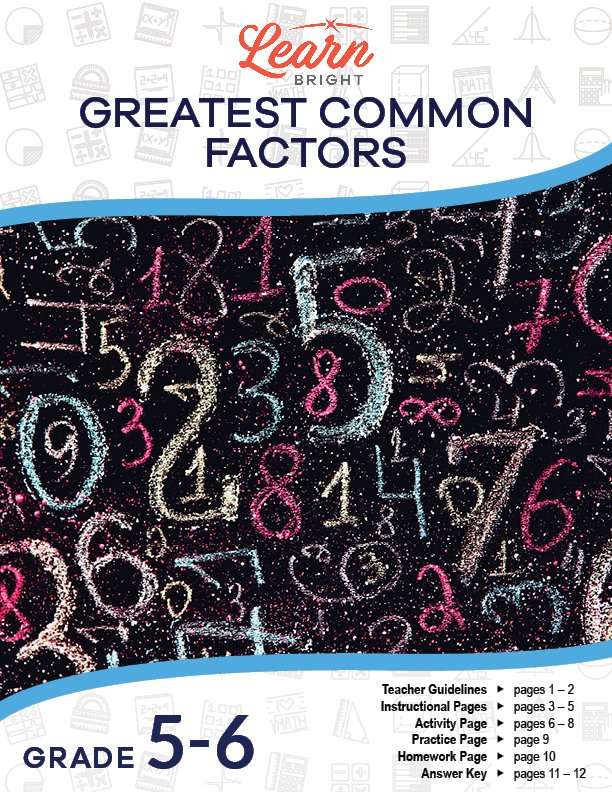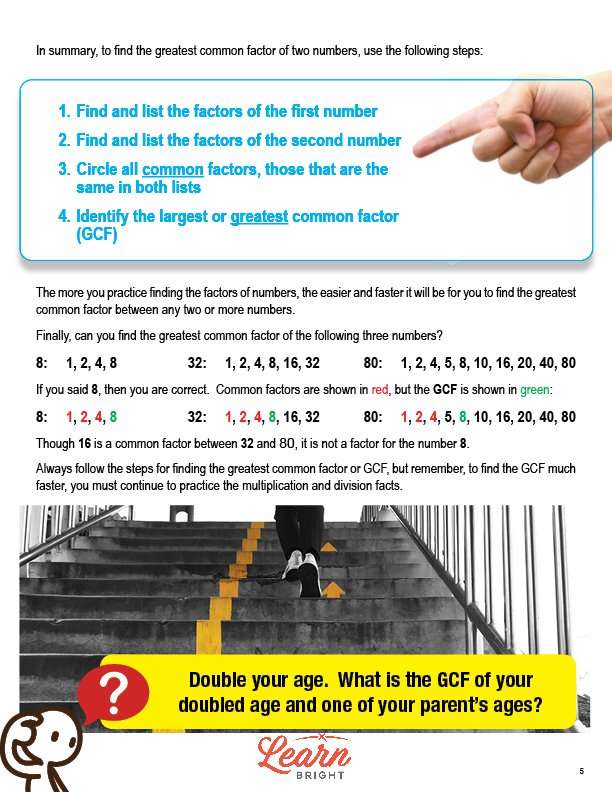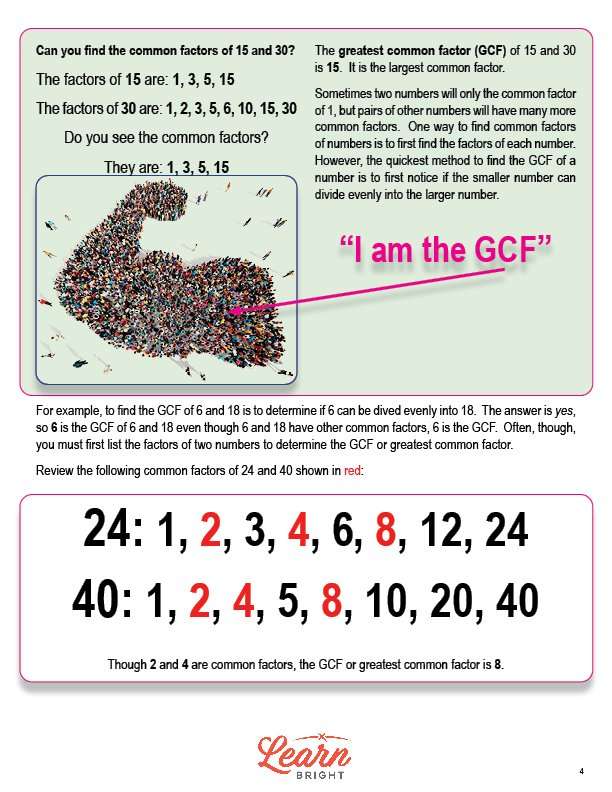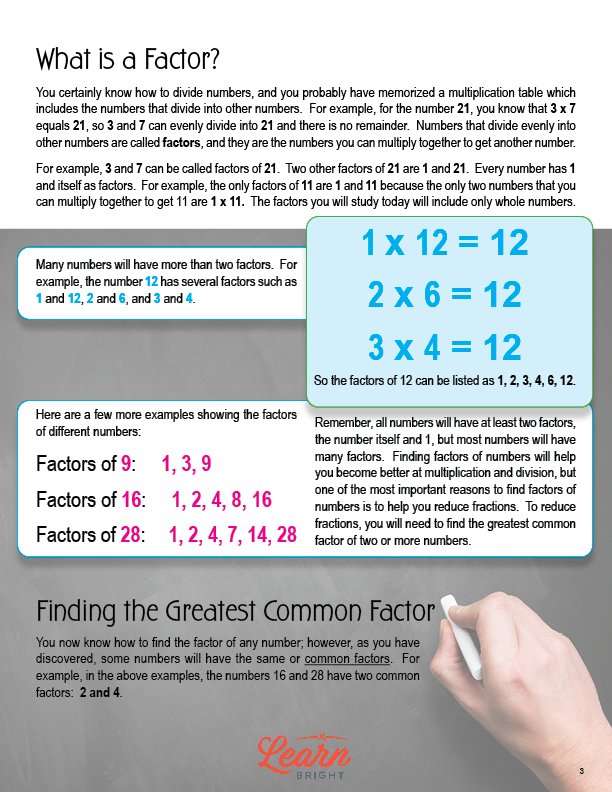Description
What our Greatest Common Factors lesson plan includes
Lesson Objectives and Overview: Greatest Common Factors teaches students how to find the greatest common factor of two numbers. At the end of the lesson, students will be able to find the greatest common factor of two whole numbers less than or equal to 100. This lesson is for students in 5th grade and 6th grade.
Classroom Procedure
Every lesson plan provides you with a classroom procedure page that outlines a step-by-step guide to follow. You do not have to follow the guide exactly. The guide helps you organize the lesson and details when to hand out worksheets. It also lists information in the blue box that you might find useful. You will find the lesson objectives, state standards, and number of class sessions the lesson should take to complete in this area. In addition, it describes the supplies you will need as well as what and how you need to prepare beforehand.
Options for Lesson
Included with this lesson is an “Options for Lesson” section that lists a number of suggestions for activities to add to the lesson or substitutions for the ones already in the lesson. One optional addition to this lesson is to allow students to search for a pattern within the list of factors for a number, to help reinforce their pattern recognition. You can also use divisibility rules to help students find factors (all even numbers will include 2 as a factor, numbers ending in 5 or 0 will have 5 as a factor, etc.). If you have more advanced students, they can use numbers larger than 100 to factor. Finally, you can use random numbers on display in the classroom, like parts of phone numbers, addresses, and more, for students find the GCF of.
Teacher Notes
The teacher notes page includes a paragraph with additional guidelines and things to think about as you begin to plan your lesson. This page also includes lines that you can use to add your own notes as you’re preparing for this lesson.
GREATEST COMMON FACTORS LESSON PLAN CONTENT PAGES
What is a Factor?
The Greatest Common Factors lesson plan includes three content pages. Students likely already know how to divide numbers and have some multiplications facts memorized. For example, they likely know that 3 x 7 = 21, so 3 and and 7 can evenly divide into 21 without a remainder. 3 and 7 are factors of 21, or numbers that divide evenly into other numbers. You can multiply factors together to get another number.
3 and 7 are factors of 21, and so are 1 and 21. Every number has itself and 1 as factors. For the number 11, for example, the only factors are 1 and 11 because they’re the only two numbers that you can multiply together to get 11.
Many numbers have more than two factors. The number 12, for example, has 1, 12, 2, 6, 3, and 4 as factors (because 1 x 12, 2 x 6, and 3 x 4 all equal 12). For the number 9, the factors are 1, 3, and 9. For 16, the factors are 1, 2, 4, 8, and 16. And for 28, the factors are 1, 2, 4, 7, 14, and 28.
Being able to find factors of numbers helps you be better at multiplication and division. It also helps you reduce fractions. In order to reduce fractions, you need to find the greatest common factor or two or more numbers.
Finding the Greatest Common Factor
Some numbers have some of the same factors as other numbers. We call these the common factors. In the earlier examples, the numbers 16 and 28 have 2 and 4 as common factors.
Let’s look at another example. Say we wanted to find the common factors of 15 and 30. First, we need to list out the factors of each number. The factors of 15 are 1, 3, 5, and 15, while the factors of 30 are 1, 2, 3, 5, 6, 10, 15, and 30. Therefore, their common factors are 1, 3, 5, and 15. The greatest common factor (GCF) of 15 and 30 is 15, because it is the largest factor that they have in common.
For some numbers, the only factor they have in common is 1. Other times, two numbers might have many common factors. To find the GCF, you can always list out the factors of each number and compare. However, an even easier method to try first is to check if the smaller number can divide into the larger number without a remainder. If it can, the smaller number is the GCF! For example, for the numbers 6 and 18, we know that 6 can divide into 18 evenly. Therefore, 6 is the GCF.
In summary, there are four easy steps that you can use to find the greatest common factor of two numbers. First, find and list the factors of the first number. Second, find and list the factors of the second number. Third, circle all of the common factors. Fourth, identify the greatest common factor. The more you practice, the easier it will be!
GREATEST COMMON FACTORS LESSON PLAN WORKSHEETS
The Greatest Common Factors lesson plan includes three worksheets: an activity worksheet, a practice worksheet, and a homework assignment. You can refer to the guide on the classroom procedure page to determine when to hand out each worksheet.
FINDING THE GCF ACTIVITY WORKSHEET
Students will work with a partner to complete the lesson activity. Each pair will cut out and fold each of the numbers printed on the worksheet. They will then randomly choose two or three of the numbers, writing them in the “numbers” column on the worksheet. Next, they will find the factors of each number and write the GCF in the space provided.
LIST THE FACTORS PRACTICE WORKSHEET
For the practice worksheet, students will list the factors for different numbers. They will also circle the common factors and GCF for some of the factors.
GREATEST COMMON FACTORS HOMEWORK ASSIGNMENT
Like the practice worksheet, the homework assignment asks students to list the factors for different numbers. They will also circle the common factors and GCF for some of the factors.
Worksheet Answer Keys
This lesson plan includes answer keys for the practice worksheet and the homework assignment. If you choose to administer the lesson pages to your students via PDF, you will need to save a new file that omits these pages. Otherwise, you can simply print out the applicable pages and keep these as reference for yourself when grading assignments.









